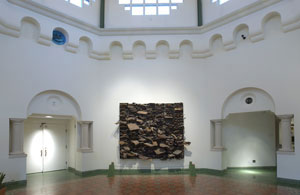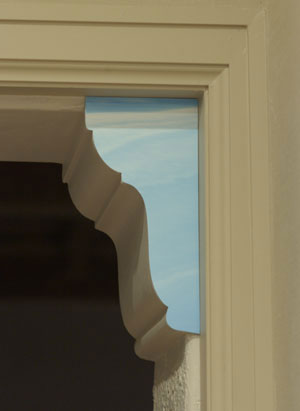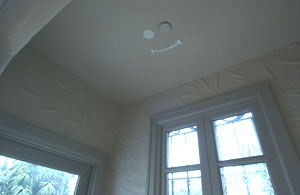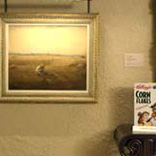The following text served as the script for a performance, Beyond post To Kellogg’s, given at the McNay Art Museum in San Antonio, October 12, 2002. As part of a new lecture series, Artists Looking At Art, I’d been asked to give a gallery talk about a piece in their collection in relation to my work, which was also installed in the museum.
The following text served as the script for a performance, Beyond post To Kellogg’s, given at the McNay Art Museum in San Antonio, October 12, 2002. As part of a new lecture series, Artists Looking At Art, I’d been asked to give a gallery talk about a piece in their collection in relation to my work, which was also installed in the museum.
The painting I chose was Jean Francois-Millet’s The Harvest.
My four works, combined in an installation titled Recess, were placed in separate locations inside the museum:
1. Diamond Jim, replacing a 16th Century statuette within a vitrine built into the wall in the foyer stairway.
2. Knock, as an overlay on a cornice molding in a hall passageway.
3. Cloud, incorporating a fire sprinkler on the ceiling of a small landing.
4. Still Here, blue mirror smiley face installed opposite a surveillance camera in one of the 24 crenellated arches in the Octagon Room.
I asked two friends, Michele Monseau and Penny Boyer, to be The Recessitators, serving as combination girl group, Greek chorus and Call and Response team, speaking or singing lines in bold.
Before we began, I introduced Penny and Michele, and gave some preparatory information on the plantation field origins of Call and Response. I explained how this was related to the blues and to the format of our performance, and placed The Harvest in a historical time frame related to the mid 19th Century plantations of the southern United States.
[From the point of view of the audience, I stand to the left of the Millet, The Recessitators to the right. The three of us hold black folders, each of which contains the script. A white placard with black letters reading a recent harvest is visible on the 19th Century table to the right of the painting. A backpack slouches on the floor beside me.]
Jean-Francois Millet:
French artist of the 1840’s and 50’s, one of a group of naturalist painters of the Barbizon School, named for a village near the Forest of Fontainebleu, southeast of Paris. His painting in the museum today, entitled The Harvest, is where our performance begins.
“Although he was officially distrusted because of his real or imaginary Socialist leanings, his own attitude towards his chosen theme of peasant life was curiously ambivalent. Being of peasant stock, he tended to look upon farm workers as narrow-minded and oblivious of beauty, and did not accept the notion that honest toil was the secret of happiness.”
He never painted outside.
How is it that we are standing in this field? We’ve no business here. Are we on a tour?
See how the harvester concentrates on his scythe, which has loosened from its staff. Work continues in the background, but his attention is given totally to the task at hand. We are standing a mere wagon’s length away, but he is completely unaware of our presence.
Let the camera eye pan backwards until we are included in the picture.Can you hear the strike of the worker’s hammer? See the fading of the light? Smell the cut of the hay? Feel the crispness of the air?
We inhabit his world like ghosts. We don’t visit from the future, but from a present happening right beside us. Just turn slightly. Now do you sense it?
The Grand Foyer of the McNay Art Museum...with Hills Snyder's Diamond Jim installed in niche (upper left)... and 16th century statuette of Mary Magdelene in opposite niche...
Plato:
The drawing is a copy of a real object, which is a copy of an ideal object.
Draw a line around an actual object or trace its outline from a photograph. The difference is due to the availability and scale of the object.
Aristotle:
A ladder means itself.
Its physical characteristics create spatial metaphors — you can never just climb a ladder. A ladder leaning against a wall connects the spatially apparent world to the world of mind.
Sculpture and Painting:
The floor is where you stand / the wall is where you look. You apprehend the floor through your body and gravity.
You apprehend the wall through vision and light. The ladder is you. Connects your gravity to your light.
Expression:
Rather than expressing myself, I’m attempting to replace myself with everything. I am admittedly asking the viewer to interpret intention in the work, but not in the way of the romantic artist. I’m not asking the viewer to figure me out. The attempt is to replace the “artist’s unconscious material” with mock-ups drawn from the cultural context. This is pretty much the prize in the cereal box school. I call it Beyond post To Kellogg’s.
These mock-ups are Representplements — they replace random subjective narratives with shared representations. These usually only resemble their real (but not more real) counterparts in profile. Present pre-sentient resentment sentiment implement implant. The unity is there, but it slinks. When the world seems strange, watch it closely. It will wink at you.
Careful:
Art is a gateway drug.
Tolstoy:
I don’t want to specify for you what to feel or what to see as beautiful, but I do cherish the acknowledgement that something in the world is beautiful, and that this thing that I’ve put into the world partakes of that.
Diamond Jim:
So what if you are Superman? How do you live in that little book?
Intentional Fallacy:
The artist who draws a line and says this line is how I felt when I drew it is deluded if he thinks the viewer can know what he felt. But if he draws the line in a context, the viewer can know that.
Three images: a bucket, a funnel and a bucket with a hole in it. These are not each the equivalent of the other, but they all relate to the same patterns of experience — open/closed; fullness/emptiness; retention/release. Your body knows these things. So does architecture. Just knock. Even better, just come in.
Psychoanalysis:
The viewer doesn’t need to know what the artist is learning. Nonetheless, the artist learns.
Formal Analysis:
First and foremost: a tool useful for making things work. It shouldn’t be the sole interpretive device. Mapping the world is an old fashioned idea.
Cloud:
Obviously, the universe is not a machine. Neither is the cloud a puppy dog.
Representation:
The present isn’t over, but you might be.
Barthes:
Yes, even still, what I’m doing is a text. The hand is there, but not. You cannot locate meaning with finality because it moves. Your observation locates it here, then there. Quickly, both are true.
Power:
As in the past, the current civilization is determined by Horse and Wheel.
Surface:
The industrial facade, the Plexiglas opaque, the mute evenness, the obliterated depth; these join the world in its’ delusion of surface.
Bas Relief:
Not really. But under the right circumstances, I can alleviate humbug.
Explanation:
You know, I’d rather just burn this place down.
Center / Margin:
Co-optation and forgetfulness happen because the individual desires the cultural center. If you’re on the margin, stay there, but move sideways. If you’re in the center, just move.
News flash from The Church of The Utterly Orthoparadox:
Don’t choose. Just move. Even if you don’t, you have.
American Taliban:
“Unique among the nations, America recognized the source of our character as being godly and eternal, not being civic and temporal. And because we have understood that our source is eternal, America has been different. We have no king but Jesus.”
— the words of John Ashcroft, American Taliban member and prime mover in the Bozo Gang.
(singing) Bozo Gang, Bozo Gang, he’s a prime mover in the Bozo Gang:
If you use themodel of human consciousness that moves from Archaic to Magical to Mythic to Modern to Post-Modern, then possibly on to something that has been posited as Integrative, then you can say that the Bozo Gang is stuck in a very bleak form of the Mythic, with fear of the Magical, collusion with the Modern, hate for the Post-Modern, with an Archaic retaliation mentality… and of course no hope for making it to the Integrative.
Verbs:
bashing (Archaic), cursing (Magical), galvanizing (Mythical), mapping (Modern), deconstructing (Post-Modern), integrating (Kellogical).
[I remove from the backpack a Disney Beauty and The Beast Special Edition box of Kellogg’s Cornflakes, and place it on the table directly behind the placard which reads a recent harvest.]
Halfrodite:
A body with archaic hands, a magical mouth, mythical heart, modern eyes and a post-modern social conscience. Legs, feet, arms, genitals, ears and guts are stored in the annex.
Daisyworld:
It’s no coincidence a cereal box is made of cardboard.
Recess:
When you stop.
When you play.
When the creative gene skips. Or hopscotch is fine.
Where you put things when you’re tired of looking where you expect to find them.
That which you forgot.
And Rhesus said, Play without ceasing.
What The Smile Says:
I’m still here.
Education:
That which seduces you into thinking you know.
How Many Post-Structuralist Theorists Does It Take to Screw In A Lightbulb:
Three: one to screw it in and one to screw it in.
News flash from The Ranch O The Beings In Flux: Erewhon is almost nowhere backwards.
Do not search for the truth; only cease to cherish opinions:
Images courtesy Hills Snyder and the McNay Museum of Art.
Hills Snyder is an artist and writer living in San Antonio, TX.







